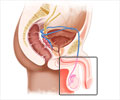Scientists believe a new blood test could help identify children at risk of obesity-related complications.

Lipid profiling identifies modifiable signatures of cardiometabolic risk in children and adolescents with obesity
Go to source). This test could offer an easier and more effective way to detect early warning signs of these conditions and help in preventative care for affected children.
‘ Did You Know?
Over 340 million children and adolescents aged 5-19 were classified as overweight or obese in 2016. #obesity #lipids #children ’





A new study reveals a new relationship between lipids and diseases impacting metabolism in children, which could serve as an early warning system for conditions like liver disease. Over 340 million children and adolescents aged 5-19 were classified as overweight or obese in 2016. #obesity #lipids #children ’
Using machines that test blood plasma in babies that already exist in hospitals, the researchers suggest this could help doctors spot early signs of disease in children quicker and help them access the right treatment.
How Lipids in the Blood Could Predict Diabetes and Heart Disease?
The findings also contest the common idea that cholesterol is a leading cause of complications around obesity in children, identifying new lipid molecules that contribute to health risks like blood pressure but are not only correlated with a child’s weight.Lipids have traditionally been thought to be fatty acids in the body, either good or bad types of cholesterol or triglycerides, fats found in the bloodstream that are the most common in the human body.
Recent studies from the same group of scientists have suggested that the picture is more complex.
Advertisement
Taking a control sample of 1,300 children with obesity, the team assessed the lipids in blood. Afterward, 200 of them were put on the HOLBAEK model for a year, a lifestyle intervention for people with obesity popular in Denmark.
Advertisement
Dr Cristina Legido-Quigley, a group leader in Systems Medicine at King’s College London, Head of Systems Medicine at the Steno Diabetes Centre Copenhagen (SDCC), and principal author, said:
“For decades, scientists have relied on a classification system for lipids that have split them into good and bad cholesterol, but now with a simple blood test we can assess a much broader range of lipid molecules that could serve as vital early warning signs for illness. In the future, this has the potential to be an entirely new way to evaluate someone’s personal risk of disease and by studying how to change lipid molecules in the body, we could even prevent metabolic diseases like diabetes altogether.”
Obesity continues to be a risk factor for conditions like fatty liver disease, but the team hopes that doctors can use these measurements to treat children when they are at risk and not just a little larger than their peers.
Dr Karolina Sulek, who was part of the study and performed analysis at the SDCC, said: “Early recognition of children at risk for these life-threatening diseases is crucial. The study provides strong evidence of the great need for obesity management and gives parents the confidence to intervene in their children’s life more compassionately, helping them to lose weight."
The next step for the researchers is to help understand how genetics affects lipids and what this means for metabolic diseases, as well as how these lipids can be changed to improve health.
Reference:
- Lipid profiling identifies modifiable signatures of cardiometabolic risk in children and adolescents with obesity - (https://www.nature.com/articles/s41591-024-03279-x)
Source-Eurekalert















